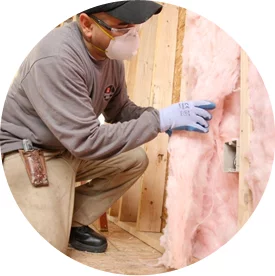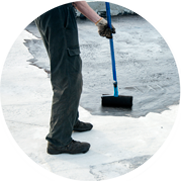You’ve probably heard of fiberglass and cellulose insulation, especially if you’re getting ready to insulate a new home or re-insulate your home. Many people aren’t sure what makes these two types of insulation different.
Fiberglass and cellulose insulation can both be blown into wall cavities, and they have similar characteristics (soundproof, environmentally friendly, etc.). However, they also have a few major differences.
Fiberglass insulation is installed dry and doesn’t absorb moisture as readily as cellulose. It’s also made up of mostly synthetic material, while cellulose insulation consists mostly of organic material, such as newspaper.
It typically takes more cellulose (by weight) to insulate a house, and it’s sometimes installed wet and needs some time to dry.
More Differences Between Fiberglass & Cellulose Insulation
Let’s talk about cellulose and fiberglass in a little more detail.
Cellulose Insulation
A widely used type of insulation, cellulose stops conductive heat flow. It’s also one of the most environmentally friendly types of insulation. It’s made of up to 80% recycled material.
Like fiberglass, cellulose is cost-effective — you’ll get what you pay for. One of the biggest benefits of cellulose insulation is its long-term energy savings. You can save up to 50% on your heating and cooling bills.
Cellulose is great for re-insulating homes, from attics to walls to crawl spaces, and, like fiberglass, offers superior soundproofing abilities.
Fiberglass Insulation
Another one of the most popular types of insulation, fiberglass is the pink insulation that resembles cotton candy and can be installed anywhere in your home — the attic, basement, walls, etc.
Fiberglass insulation can be a blanket system of batts and rolls, or it can be blown in. It’s also one of the most cost-effective types of insulation.
Like an oven mitt protects your hand from heat, fiberglass insulation traps warm air in its tiny fibers through conductive heat transfer. Like cellulose, fiberglass insulation reduces outside noises and noises between different levels and floors in your home.
Cellulose vs. Fiberglass Insulation Similarities & Differences
The main similarities between fiberglass and cellulose insulation are:
- Soundproofing
- Environmentally friendly characteristics
- Blown-in installation
- Suitability for many different areas of homes
The main differences between fiberglass and cellulose insulation are:
- Organic vs. synthetic materials (cellulose is made mostly of newspaper)
- Color (fiberglass is pink and cellulose tends to be more grayish-white)
- R-value and weight
Contact the insulation experts at ThermaSeal/Lakeside Insulation today to learn more about cellulose versus fiberglass.




